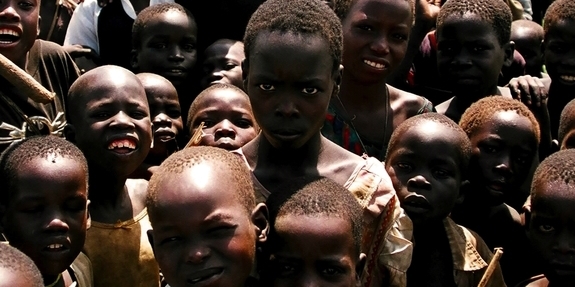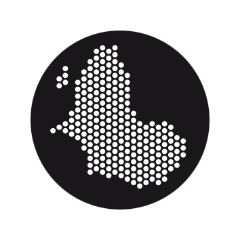A mysterious new illness affects children in Uganda's refugee camps.
“We think it’s the life from the camps,” says local council leader Dickens Opar, of Pader district in North Uganda, when asked about the mysterious and devastating ‘nodding disease’ that has affected, at latest count, more than three thousand children in this region of North Uganda. “Or bombs from the insurgency.”
Nodding disease, a debilitating form of epilepsy, affects mainly children
Nodding disease, a debilitating form of epilepsy, was first noticed in the region in 2007, shortly after the ceasefire with Joseph Kony’s Lord’s Resistance Army which had kidnapped children, turned them into soldiers and forced them to attack their own villages. But the victims of the disease were not ‘Kony’s children’. Those affected, always children between the ages of 3 and 15, had all grown up in government-run ‘Internally Displaced People’ camps, set up to shelter those fleeing from Kony. The sick children characteristically nodded their heads for hours at a time, and had epileptic seizures.
It was first noticed in the northern Ugandan region shortly after the ceasefire with warlord Joseph Kony in 2007
Later on, if left untreated, growth was stunted and mental retardation followed. The disease, which still baffles doctors and scientists, has led to the deaths of around three hundred children to date and has driven thousands of families to despair, especially since the Ugandan government ignored the new suffering in its northern region for years.
But mass protests, which became very vocal in 2011 when they were joined by local MPs, councillors and media, brought a change. Now, increasing numbers of children are getting, and responding to, treatment.
Walter Ojok (now 15), raised in Awere Internally Displaced People’s camp since he was born, was ‘a normal healthy baby’, his mother, Agnes, says. But at eight years old he started having seizures where he would nod his head for two hours at a time and jerk violently, ‘especially at the sight of food’. Sanata Akwero from Odek village reports the same thing about the first symptoms, nine years ago in 2005, of her now 16 year old son: “Whenever food was served [in the camp, BA], he nodded his head and failed to put the food into his mouth. Sometimes, he lost balance and fell to the ground.” It is this connection of the seizures to looking at food that is common to all sufferers, and is puzzling scientists to date.
Burning and drowning
Walter Ojok now curls into a corner of the floor of an empty room in his house in Odek village. From there, he watches other children playing, but when he tries to rise his legs crumble under him, sending him crashing back to the floor. He looks no older than five, with a thin body, chest sticking out and hunched back. His eyes are teary and saliva streams down his thin lips. When he raises his hands as if to call for assistance, his arms show scars. “He fell on a cooking fire when he suffered a seizure in 2012,” explains his mother. Many children with nodding disease have similar burn scars. Victims have also drowned when they happened to be crossing patches of water when a seizure came on.
Marolena Acan, from La Orogali village in Pader District, whose twelve year old daughter has been suffering from the illness since she was four, sighs that ‘the child is wasted’ and admits that her family is ‘waiting for the day God will let her rest’. Several other parents, too, have given up on their children; they are abandoning the sick ones because they simply cannot take care of them any longer. Sometimes older siblings take care of the sick kids, but they also don’t have the money to feed or treat them. Marolena Acan’s sister-in-law, Rosemary Apio, has two sick children too.
Safe from Kony, but sick at the sight of food
‘Nodding disease’ has been previously reported in areas affected by civil war and displacement in Tanzania, South Sudan and the West Equatorian region of South Sudan. The latter two areas are close to the North Ugandan area that now seems the epicentre of the disease. Puzzlingly, returned child soldiers who spent years in camps of a different type – with rebel leader Joseph Kony – seem immune to a large extent.
Observers in the area now ask how the guerrilla camps could have been different from the ‘Internal Displacement’ camps: after all, basic amenities like food, safe clean drinking water and hygiene were lacking in both types of camps. Furthermore, the Kony camps came with the added horrors of daily violence, whilst the refugee camps were safe havens away from the ruthless rebels.
Was there perhaps more to eat in the Kony camps? Did it make a difference that rebels could go out and actively plunder to get food, whilst in the refugee camps one grew up in passivity, endlessly waiting to be fed? Significant numbers of children with nodding disease start to seize and jerk when they recognise food. It is the only common factor in the disease that relates to a specific impulse from the outside world.
There is a tablet that helps: a generic anti-epileptic that shortens the duration of head nodding and reduces the number of seizures from an average of eight to three per day. The Ugandan government last year produced about a million of these and made them available to the now seven rehabilitation centres in the region. Ojok takes it, and he can now utter a few intelligent words at a time, telling us his seizures went down from twelve per day in 2011 to around six today. He has also learned to write his name. It takes him six minutes, but it’s a big improvement compared to a few years ago.
Forcing the government to act
The treatment centres came about in 2012, as part of a US$ 3,5 million ‘national response plan’, which, after years of lacklustre responses and denial, followed an equal number of years of whistleblowing by local families, health workers and journalists. As the cases grew in number, they had increasingly loudly complained about the neglect by the government of this new plague in the region that had already suffered so much during the civil war. The local Acholi Times in particular campaigned for the government in Kampala to finally show a ‘human heart’ and do something for the affected people, even if the cause and cure of the disease were still unknown.
When, in 2011, the individual activist and media protests were joined by local politicians, district councillors and MPs, the government finally listened. Local MP Regan Okumu received much acclaim when he threatened – after the government finally treated a small number of children in a regional hospital – that all children suffering from the disease would be taken to Kampala “to get the same treatment.” “We shall help them (by ferrying) all the affected children to Kampala to get treatment since it seems that is the only language they will listen to,” said Okumu.
The Acholi District Parliamentary Group then also warned that they would camp at the ministry headquarters as the year closes, ‘to mourn for the children who have since passed on’ as a result of the nodding disease.
Witch doctors and prayers
Though the situation has improved since the government finally erected the treatment centres in 2012, it is still far from ideal. Many people live far away from the centres and can’t take their weakened children there, or leave them at home alone whilst they go to obtain medicine. Many families, meanwhile, resort to local witch doctors. “My mother-in-law is a traditional healer; she has helped treat many ailments in this village and many people still flock to her shrine, but her granddaughters’ cases have puzzled us,” said Monika Ogenga, who has five children, three of which suffer from the disease. Ogenga believes that her daughters are still alive because of the herbal concoctions that their witchdoctor grandmother is giving them. Pointing at a brown liquid in a jerrican: “When they take this, they gain strength and get better.”
Evelyn Auma (48), however, reports that nothing helps her son and daughter, who have suffered from the disease for three years now. “I tried treatment in Kitgum hospital [the local medical centre, BA], and I even tried a witch doctor.” The witch doctor, blaming the disease on evil witches, “asked me to take a white cock to cleanse my children and slaughter a black goat to take away the bad spirits, but they only got worse.” She says she cannot understand why her son and daughter should be sick whilst she herself is healthy. “At the camp, we ate the same food, drank from the same pot, how is it that I am not affected?”
Other parents, too, report that not knowing where the disease comes from adds extra torment. “If I just knew what caused this, maybe I wouldn’t be so helpless. We don’t know if it’s the camp life or a curse from God,” says Rosemary Apio, of La Orogali.
The latest report from the World Health Organisation confirms that “the populations where the nodding disease is known to occur have either suffered from displacement in the past or are currently displaced. In an observational study from South Sudan, nodding disease cases were observed in three out of four villages; the one village without known cases was the only one that had not experienced internal displacement.” Medical workers have also suggested a connection with food shortages experienced during the war, the war itself, and displacement and the associated trauma.
The bus to Kampala
But whatever the actual cause of the disease may be, many families do report improvement when their children are treated, and that is where the focus of local activists, for now, remains. In an effort to increase the pressure on government and obtain a wider spread of health care services in the region, local MP Beatrice Anywar stepped in the ring in October last year. She put into practice what her colleague MP Reagan Okomu had threatened two years before: she gathered over thirty victims of the disease together, put them in a bus to Kampala and rode along. When the bus was intercepted by the police along the way, she stood her ground. The police was forced to allow the bus to proceed to the capital, where the children were admitted at Mulago National Referral Hospital and given treatment for their seizures as well as fortified foods.
The Ugandan government ignored the suffering until activists started taking sick children in buses to Kampala
Anywar, together, with a team of NGOs and fellow MPs from the region, also took the government to court on the matter of negligence in a health emergency. Last week, the government opted to settle the matter outside court and agreed to set up a health team of medical workers and local leaders which is to consult affected people on their needs. “The government has been lax,” said Anywar in an interview. “They didn’t deliver food or medicines to the treatment centres between December and March. Sometimes, the food they deliver is rotten.”
The MP clearly intends to keep the authorities on their toes. She is now raising funds abroad (‘with help from Ugandans in the diaspora’) for local health initiatives and also continues to work with NGOs in efforts to build a special needs school and a home for those children who can’t be cared for by their families. These homes, where children are given medicines and balanced diets, work well, says director Angwech Collins of Hope for Humans, of one of the main NGOs involved in such projects. “The children in our centre are improving fast. They came when they could barely walk, but we have seen them run, play and live a happy life.”
Puzzling links
Meanwhile, in the quest to understand the disease, the US-based Centre for Disease Control has taken ten children affected by the ‘nodding disease’ to its headquarters for further investigations, but there are no results reported from those tests yet. General research has so far only noted that the disease has a tendency to occur in regions where there are also high incidences of onchocerciasis, or ‘river blindness’, a disease brought on by a river parasite. This does, however, not mean that all those who have river blindness also get nodding disease, or vice versa.
Another element in both river blindness and nodding disease is vitamin B6 deficiency. This has piqued the interest of scientists because the deficiency also appears in conjunction with other types of childhood epilepsy. Other studies link the disease to malnutrition, but it is not known if malnutrition is a cause or a result of the disease, since children who start nodding and seizing when they see food cannot eat and therefore become (even more) undernourished.
Nodding disease seems to affect only children who grew up in refugee camps
But even when all that is taken into account, the question remains why – when problems of malnutrition, river parasites and vitamin deficiencies affect practically all poor families in many regions in developing countries – sufferers to date have all grown up in refugee camps. Or why former child soldiers of Kony’s guerrilla army, though they suffered many horrors of a different type, so far seem immune.
Barbara Among is an investigative reporter covering conflict, human rights, terrorism, politics, business, health and environment. She works on a free-lance basis with The East African newspaper.


